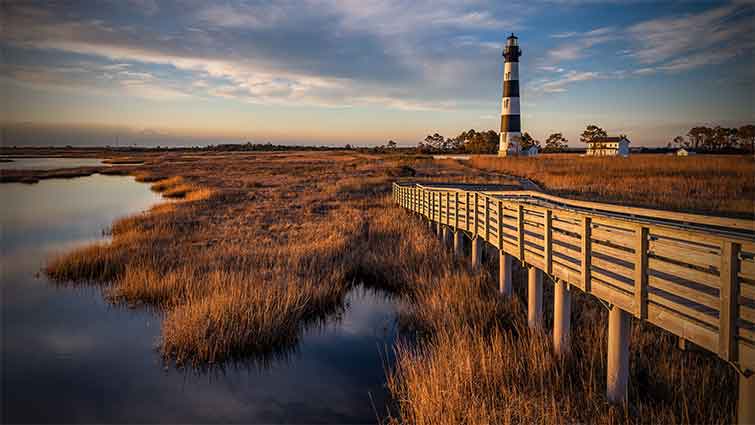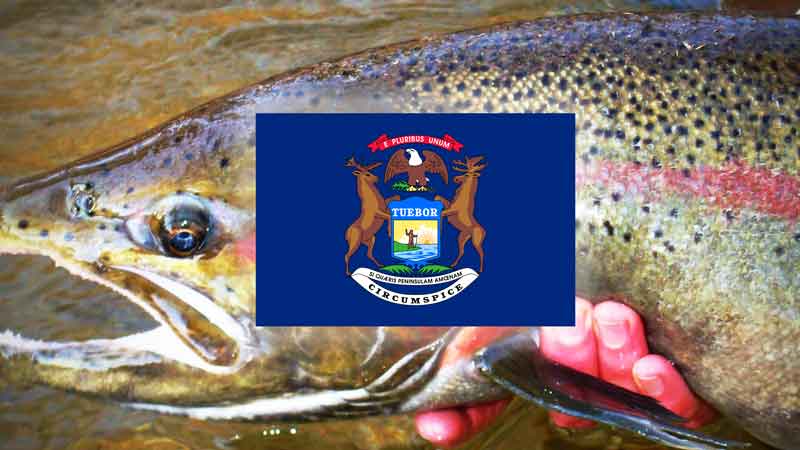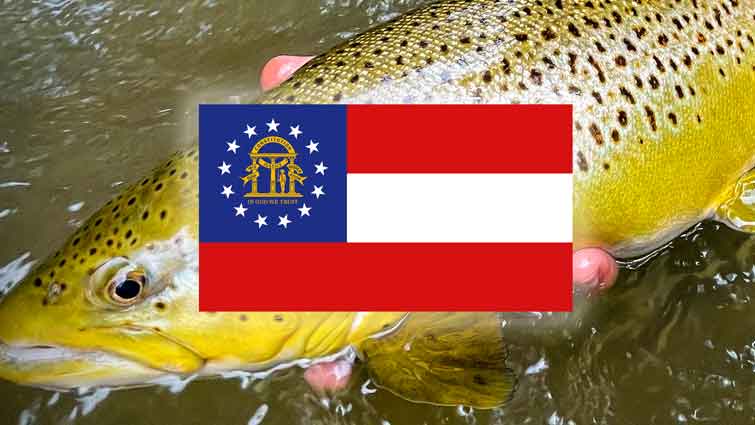North Carolina is a state blessed with abundant natural beauty, and its many rivers, streams, and lakes offer some of the best fly fishing in the country. Whether you’re after trout, bass, or other species, there’s a perfect spot for you in this state.
Some of the best places to fly fish in North Carolina include:
- Davidson River
- Falls of Neuse Lake
- Helton Creek
- Lake Fontana
- Linville River
- Mitchell River
- Nantahala River
- Nolichucky River and more

Because North Carolina has such a diverse landscape, the fly fishing options are endless. Saltwater fishing is also available off the coast. So, whether you’re a beginner or an experienced fisherman, pack your gear and head to North Carolina for some of the best fly fishing in the country. This article will take you to thirteen of the best places for fly fishing in NC!
Best Fly Fishing locations in North Carolina
From rivers to lakes, North Carolina offers endless opportunities for fly fishing. Here are some of the best locations in the state:

1. Davidson River
The Davidson River flows through the Pisgah National Forest and is regarded as one of North Carolina's finest trout rivers by experts and small-time fishermen. Fly fishing is permitted from the headwaters to the confluence with Avery Creek, except for catch-and-release only with artificial lures throughout the year.
The state maintains and stocks the river below that point. You may catch plenty of excellent fishing throughout the year, including in underutilized headwater regions.

Recommended Fly Patterns for the Davidson River, North Carolina:
2. Falls of Neuse Lake
Falls Lake is a large reservoir in Durham, Wake, and Granville counties of North Carolina, United States, with a surface area of 12,410 acres (50 km²). The Neuse River source at the junction of the Eno, Little, and Flat rivers extends 28 miles (45 km) up the river to Falls Lake.
The lake is named for the Neuse Falls, a once white-water stretch of the river that fell from the Piedmont into the lower Coastal Plain and was submerged during the construction of the lake. It provides drinking water for several communities, including Raleigh, aids in flood control, and serves as a recreational area and wildlife habitat.

Recommended Fly Patterns for the Falls of Neuse Lake, North Carolina:

3. Helton Creek
Helton Creek, located in the hills of Ashe County and part of North Carolina's delayed-harvest trout program, is a treasure. Approximately 26,600 catchable-size trout are introduced annually into Helton Creek's delayed-harvest section. Approximately 3,750 catchable trout are stocked in October, November, March, April, and May.
Helton Creek is available from the Virginia border to the junction with the New River. One advantage of Helton Creek during the delayed-harvest period is that it's one of the longest stretches of delayed-harvest stream in West Virginia, at 8 miles. There are plenty of runs, pockets of water, and pools where you can catch fish.

Recommended Fly Patterns for the Helton Creek, North Carolina:
- Kaufmanns Stimulators - Olive - Size 12
- Barbless Flashback Hare's Ear - Size 14
- Glo Bug Red Dot Orange - Size 10

4. Lake Fontana
Fontana Lake is a reservoir formed by Fontana Dam on the Little Tennessee River in Graham and Swain counties of North Carolina. The lake, which forms part of the southern border of the Great Smoky Mountains National Park and part of the northern border of the Nantahala National Forest, is about 17 miles (27 km) long when full.
The lake has several inlets and islands, particularly near the eastern end, as a result of former mountain peaks being split off.

Recommended Fly Patterns for Lake Fontana, North Carolina:
- Double Bunny Olive & White - Size 6
- Slump Buster with Cone - Black - Size 8
- Zoo Cougar - Yellow - Size 6

5. Linville River
The Linville River is a river in North Carolina's western region. The Linville River begins on the slopes of Peak Mountain, Sugar Mountain, and Flattop Mountain in the Linville Gap area (also known as Tynecastle). It flows south through Avery County's towns of:
- Grandfather
- Linville
- Pineola
- Crossnore, and
- Linville Falls.
The Linville River flows south from Linville Falls, through the Linville Gorge, and into Lake James, where it forms the backdrop for the Linville Falls and Linville Falls State Park. The river ends at Lake James after traveling about 30 miles (48 km) along the Catawba River.

Recommended Fly Patterns for the Linville River, North Carolina:

6. Mitchell River
The Mitchell River in Northwest North Carolina is a tributary of the Yadkin River and part of the watershed of the Pee Dee River, which flows to the Atlantic Ocean and joins with numerous other rivers. The Mitchell begins in eastern Alleghany County in the Blue Ridge Mountains and generally flows south eastwardly, merging with the Yadkin River 5 miles (8 km) northeast of Elkin at Burch.
The North Carolina Wildlife Resources Commission's delayed catch is a popular program in which rainbow, brook, and brown trout are stocked in spring and fall. Anglers may only keep their catches from early June through September, resulting in better fishing throughout the year. Delayed harvest fishing is accessible on the Mitchell River near Kapps Mill along River Road.

Recommended Fly Patterns for the Mitchell River, North Carolina:

7. Nantahala River
The Nantahala River is a major river in western North Carolina, flowing through the Nantahala National Forest and close to the Great Smoky Mountains National Park. The two-lane US 19/74 highway runs along the river, with picnic spots dotting the route.
The Nantahala River rises close to the border between Georgia and North Carolina, near the Southern Nantahala Wilderness and the Appalachian Trail. It empties into Fontana Lake, which was formed behind Fontana Dam.
The deep, clear waters of the Nantahala are home to trophy trout and wild trout due to the ideal characteristics of tailwater, which provides fresh flows of cold, clean oxygenated water with the nutrients needed for a limestone stream. The Nantahala River is also a hatchery-supported stream stocked from March through October.

Recommended Fly Patterns for the Nantahala River, North Carolina:

8. Nolichucky River
The Nolichucky River is a 116-mile (185 km) river that flows through Western North Carolina and East Tennessee in the southeastern United States. The river's watershed, which runs through the Pisgah National Forest and the Cherokee National Forest, contains some of the highest mountains in the Appalachians, including Mount Mitchell in North Carolina, which is the tallest peak in the eastern United States.
The Nolichucky is formed by the confluence of the North Toe River and the Cane River in Huntdale, North Carolina. The Nolichucky rises in Huntdale, North Carolina, as the confluence of the North Toe River and Cane River.

Recommended Fly Patterns for the Nolichucky River, North Carolina:

9. Oconaluftee River
The Oconaluftee River, which drains the south-central Oconaluftee valley of the Great Smoky Mountains in Western North Carolina, empties into the Tuckasegee River. The Qualla Boundary, a federal land trust that serves as a reservation for the Eastern Band of the Cherokee (EBCI), is located along its banks.
The Oconaluftee River in Cherokee is a brown trout, rainbow, brookie, and palomino creek with large size. The Tribe's hatchery stocks it twice each week, making it an ideal spot with convenient access along the entire river length.

Recommended Fly Patterns for the Oconaluftee River, North Carolina:

10. Oregon Inlet
The Oregon Inlet is a channel that connects the Pamlico Sound with the Atlantic Ocean on North Carolina's Outer Banks. It links Bodie Island with Pea Island, which is connected by the 2.8-mile Marc Basnight Bridge, which spans the inlet. Oregon Inlet is an important departure point for charter fishing trips, as it is one of the few access points to the sea along this stretch of coast. The inlet is also the location of a US Coast Guard motor lifeboat station.
The Oregon Inlet Fishing Center, with a Full-Service Marina, is located 8 miles south of Whalebone Junction on NC 12 at the north end of the Basnight Bridge in the beautiful Cape Hatteras National Seashore.
Recommended Fly Patterns for the Oregon Inlet, North Carolina:
- Clouser Deep Minnow in Various Color - 4 to 1/0
- Small Poppers - Size 6
- Crazy Charlies - Size 6

11. Raven Fork
Raven Fork is a freestone creek in the Great Smoky Mountains National Park (GSMNP). The upper Raven Fork is quite remote and is the most difficult watershed in the National Park. For years, logging firms have avoided this territory, allowing ancient trees to tower above you and fish to rarely encounter a fly or angler.
Some of the finest brook trout are fishing in the Smokies after the Enloe Creek junction and steel truss bridge. This area is typical of steep plunge pools, tiny waterfalls, and deep holes. Raven Fork has a distinctive appearance from other streams in the Smokies. Large rocks and crystal clear water make any cast look like it's going to spook the fish.

Recommended Fly Patterns for the Raven Fork, North Carolina:

12. Rocky Broad River
The Rocky Broad is a warmer river with lower elevation levels, reaching a depth of 1048 feet. The river flows into Lake Lure and attracts large fish from all species. In Henderson and Rutherford Counties, close to Asheville, the river runs through the Rocky Broad Preserve.
The name comes from the numerous large boulders that line the river's banks. The Rocky Broad is recognized for its stocked trout in the higher regions near Bat Cave. In the mouth of the stream, which is nearest to the lake, smallmouth and largemouth bass, rainbow, brown, and brook trout are among the most common species present.

Recommended Fly Patterns for the Rocky Broad River, North Carolina:

13. Shearon Harris Lake
Shearon Lake, also known as Shearon Harris Reservoir, is a reservoir in New Hill, North Carolina. The lake covers 4100 acres (17 km2) and is situated 220 feet above sea level in southwestern Wake County and southeastern Chatham County.
Bass can be found at any time of year, but the seasonal population will vary. If you go in the spring, you'll encounter a lot of younger female bass in shallow water. The shallows are fantastic throughout much of the summer. Many fish migrate to deeper waters as the water gets warmer. This will take longer in a boat, but there are still plenty of opportunities to get a nice catch all year round.

Recommended Fly Patterns for the Shearon Harris Lake, North Carolina:
- Zonker - Grizzly - Size #6
- Clouser Crawdad - Size #6
- Bass Popper - Size #6

14. South Mills River
The South Mills River is located in Pisgah National Forest and is known for its enormous wild rainbows and browns, which are larger than many nearby streams. It's on the outskirts of Asheville near the Blue Ridge Parkway, and it has about 12 miles of stream access for trout fishing. Due to the crystal clear water, these fish are a little more sky and require a little more effort to lure from their hiding places.

Recommended Fly Patterns for the South Mills River, North Carolina:

15. South Toe River
South Toe River is a river located in Yancey County, North Carolina, that flows north to south. The name South Toe was derived from its original Indian name, which was pronounced "S - ta - toe," and referred to the Estatoe trade route that led down from the NC mountains through Brevard into South Carolina, where a village of the same name existed.

Recommended Fly Patterns for the South Toe River, North Carolina:

16. The Bridges of Dare County
The Wright Memorial Bridge, the William B. Umstead Bridge, and the Virginia Dare Memorial Bridge are three main bridges linking the Outer Banks to North Carolina's mainland. Anyone aged 16 or older who goes to the Outer Banks to fish in North Carolina's coastal waters must buy and carry a Coastal Recreational Fishing License or CRFL (Coastal Recreational Fishing License).
Fishing from any of the bridges is a great way to catch flounder, bluefish, pompano, Spanish mackerel, sheepshead, and drum. The best time to fish from the bridges is during the fall and winter months when the water is cooler, and the fish are more active.
Recommended Fly Patterns for the The Bridges of Dare County, North Carolina:
- Clouser Deep Minnow - Black over Orange - 4 to 1/0
- Clouser Deep Minnow - Chartreuse over White - 4 to 1/0
- Crazy Charlies Size 6

17. Toe River
The North Toe River is a tributary of the French Broad River, and its source is in Sugar Gap, between Bald Mountain and Sugar Mountain. Before merging with the Nolichucky River at Sugar Gap, it meanders 73.6 miles (118.4 km) westerly through Avery, Mitchell, and Yancey counties.
Fishing in the Toe River is good for smallmouth and largemouth bass, sunfish, trout, and catfish. The best time to fish is during the spring and fall when the water is cooler, and the fish are more active.

Recommended Fly Patterns for the Toe River, North Carolina:

18. Tuckasegee River
The Tuckasegee River, or "The Tuck," runs solely through western North Carolina and runs the full width of Swain County, to be exact. The Tuckaseegee rises in Jackson County above Cullowhee at the confluence of Panthertown and Greenland creeks. It continues northwest into Swain County, where the Oconaluftee joins it before the Tuckaseegee heads northwest. Fishing here requires a North Carolina fishing license with a trout stamp.
Tuckasegee species include brown and rainbow trout, smallmouth bass, steelhead, muskie, bluegill, yellow perch, and Catfish.

Recommended Fly Patterns for the Tuckasegee River, North Carolina:
- Elk Hair Caddis CDC- TAN - Size 16
- Rainbow Warrior Jigged- Tungsten - Barbless - Size 14
- Muddy buddy - Black - Size 6

19. Watauga River
The Watauga River is a major stream in western North Carolina and east Tennessee. It has its source at Linville Gap, South Fork Holston River, to Boone Lake, where it is 78.5 miles (126.3 km) long with the headwaters of the South Fork Holston River. The spring that feeds the Watauga River emerges from the base of Peak Mountain in Avery County, North Carolina, on the west side of the Continental Divide.

Recommended Fly Patterns for the Watauga River, North Carolina:

20. Wilson Creek
Wilson Creek is located in the Pisgah National Forest, in the northwestern section of Caldwell County, North Carolina. Wilson Creek's water system originates in Calloway Peak and runs for 23 miles before merging with John's River. This popular fly fishing destination has been a part of the Wild and Scenic River System since 2000.

Recommended Fly Patterns for the Wilson Creek, North Carolina:
What Gear do I need to Fly Fish in North Carolina?
It goes without saying that you're going to need a fly rod and reel and a good selection of flies for your NC fly fishing adventure.
The most important thing you need for fly fishing in North Carolina is a good pair of waders. Waders and waterproof boots will help keep you dry while fishing in cold or deep water. A good pair of waders will also keep you warm in colder weather.
Additional Facts about Fly Fishing in North Carolina
Is fly fishing good in North Carolina?
North Carolina offers some of the best fly fishing in the country. There are many different types of fish that can be caught on a fly rod, including trout, bass, and panfish.
North Carolina is a great state for fly fishing, with many natural and stocked waterways and plenty of saltwater fishing. The state is home to some of the best fly fishing in the country. From world-famous trout streams to secluded mountain creeks, North Carolina has it all.

When can I fly fish in NC?
The best time to fish in NC is during the spring and fall. The weather is milder during these seasons, and the fish are more active. Because the Wildlife Commission restocks approximately 1,000 miles of trout streams each year, there are times when some streams are closed.
Fly fishing in NC is open at 7 a.m. on the first Saturday in April and closes 30 minutes before sunset on February 28th each year, allowing anglers to catch up to seven trout per day with no minimum size or bait restrictions.
Do I need a special license to trout fish in NC?
You will need a North Carolina fishing license with a trout stamp to trout fish in NC. You can purchase a license online, at any Wildlife Service Agent, Division of Marine Fisheries Office, or tackle shop. A 1-year resident license costs $16, and a non-resident license costs $32.
North Carolina offers some of the best fly fishing in the country. With many different types of fish to catch and plenty of waterways to explore, NC is a great destination for fly anglers of all levels. Before heading out, be sure to purchase a North Carolina fishing license with a trout stamp and check stream conditions.






1 comment
Mack Sawyer
Do you have this nc info in a printed form?
Do you have this nc info in a printed form?